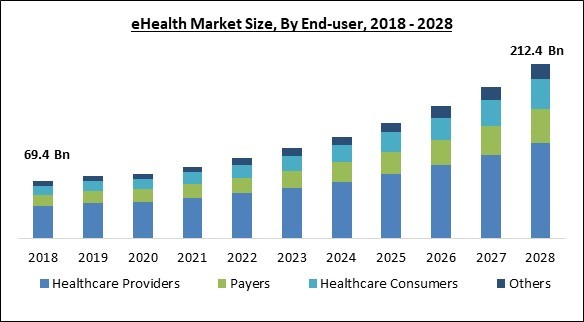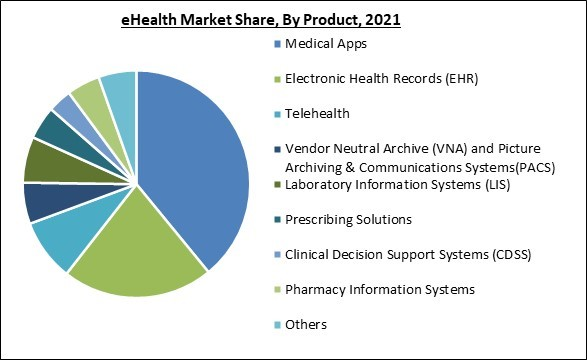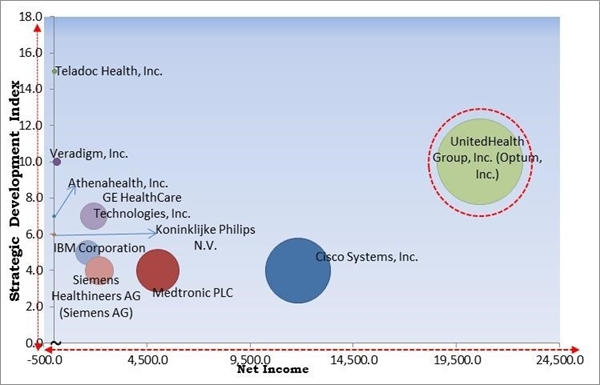The Global eHealth Market size is expected to reach $212.4 billion by 2028, rising at a market growth of 13.9% CAGR during the forecast period.
The application of information & communication technology (ICT) for health is known as 'eHealth'widely. Medical apps, health records, and telemedicine have all used ICT extensively. E-health allows it to keep hospital patient, employee, and financial data online. The process of keeping healthcare data has changed as a result of this. The medical team initially entered data manually. Contrarily, all patient data is currently accessible in seconds, and only a single unique identification number is needed.
eHealth has several advantages over traditional clinical data management techniques, including eliminating manual record-keeping and facilitating quick access to patient information. Additionally, it is projected that automated & interoperable healthcare information systems would optimize payment for ambulatory and inpatient healthcare providers while enhancing patient happiness, lowering healthcare costs, increasing efficiency, reducing mistakes, and improving medical care.
The main factors driving the eHealth market are the expansion of government programs promoting the use of e-health products and services, the rise in the demand for e-health solutions to manage regulatory compliance, and the shortage of healthcare workers. In contrast, more prospects in developing countries, the growth of the mHealth, telehealth, and remote patient monitoring sectors, and an increase in the adoption of e-health solutions in outpatient care facilities are anticipated to offer attractive growth opportunities for the market.
The major strategies followed by the market participants are Partnerships. Based on the Analysis presented in the Cardinal matrix; UnitedHealth Group, Inc. (Optum, Inc.) are the forerunners in the eHealth Market. Companies such as Cisco Systems, Inc., GE HealthCare Technologies, Inc., and Medtronic PLC are some of the key innovators in eHealth Market.
The market research report covers the analysis of key stake holders of the market. Key companies profiled in the report include Medtronic PLC, IBM Corporation, Cisco Systems, Inc., GE HealthCare Technologies, Inc., Veradigm, Inc., Koninklijke Philips N.V., Siemens Healthineers AG (Siemens AG), Teladoc Health, Inc., UnitedHealth Group, Inc. (Optum, Inc.), and Athenahealth, Inc. (Veritas Capital).
The application of information & communication technology (ICT) for health is known as 'eHealth'widely. Medical apps, health records, and telemedicine have all used ICT extensively. E-health allows it to keep hospital patient, employee, and financial data online. The process of keeping healthcare data has changed as a result of this. The medical team initially entered data manually. Contrarily, all patient data is currently accessible in seconds, and only a single unique identification number is needed.
eHealth has several advantages over traditional clinical data management techniques, including eliminating manual record-keeping and facilitating quick access to patient information. Additionally, it is projected that automated & interoperable healthcare information systems would optimize payment for ambulatory and inpatient healthcare providers while enhancing patient happiness, lowering healthcare costs, increasing efficiency, reducing mistakes, and improving medical care.
The main factors driving the eHealth market are the expansion of government programs promoting the use of e-health products and services, the rise in the demand for e-health solutions to manage regulatory compliance, and the shortage of healthcare workers. In contrast, more prospects in developing countries, the growth of the mHealth, telehealth, and remote patient monitoring sectors, and an increase in the adoption of e-health solutions in outpatient care facilities are anticipated to offer attractive growth opportunities for the market.
COVID-19 Impact Analysis
The eHealth market is being driven by ongoing improvements in mobile technology, which are assisting in spreading eHealth programs. The ability to share information across various places is made feasible by telehealth systems for healthcare practitioners. In addition, the usage of home telehealth solutions increased dramatically for IT organizations during the continuing COVID-19 pandemic. On the other hand, many governments have published telemedicine guidelines to address the requirements of remote, difficult-to-reach populations. As a result, the eHealth market is expected to increase during the forecast period.Market Growth Factors
Surged use in outpatient care facilities
E-health and telehealth will advance with information science, technology, medicine, and biotechnology advancements. As a result, patients and healthcare workers in the future will be much more accustomed to using cutting-edge equipment, services, and software. Also, it is becoming increasingly clear that eHealth allows healthcare professionals to improve health systems and convert them from 'detect and treat'to 'predict and prevent'models. As a result, activities using eHealth solutions are growing, becoming more prevalent in outpatient treatment, and are anticipated to present opportunities for the eHealth market.Increased innovations and technological advancements
Businesses in the eHealth market are enhancing the benefits of deep medical learning to anticipate individuals' risks of dementia and Parkinson's. Numerous businesses are gaining expertise in artificial medical intelligence (AI) that predicts likely patient disease patterns. Several researchers have launched research projects using medical AI to examine non-invasive interconnections between brain areas to identify mental diseases in patients at very early stages. Hence, IT businesses should engage with academics and innovators to minimize the necessity for surgical treatments in the early diagnosis of mental diseases. Possible innovations and technological advancements are predicted to support the growth of the eHealth market in the upcoming years.Market Restraining Factor
Medical practitioners' reluctance to accept innovative eHealth solutions
Physicians are restricting to adopt these systems because of their complexity & lack of user-friendliness in modern healthcare IT systems. Several doctors believe that using healthcare Technology solutions hinders their ability to communicate with patients. Also, in remote locations, issues including a lack of internet technology and a dearth of professionals accessible to offer technical assistance are to blame for doctors' reluctance to utilize HCIT solutions. All of these elements are having a negative impact on how quickly healthcare businesses adopt eHealth technologies.Product Outlook
Based on product, the eHealth market is segmented into medical apps, electronic health records (HER), telehealth, vendor neutral archive (VNA) & picture archiving & communications systems (PACS), laboratory information systems (LIS), prescribing solutions, clinical decision support systems (CDSS), Pharmacy Information Systems, and others. In 2021, the medical apps segment held the highest revenue share in the eHealth market. This is ascribed to an increase in the demand for high-quality healthcare products and services, an increase in the acceptance of mHealth practices, a surge in need for better patient safety and care, and a rise in government efforts to advance e-health. Also, the rapid uptake of tablets, smartphones, and other handheld devices is fueling the market's expansion.End-user Outlook
On the basis of end-user, the eHealth market is divided into healthcare providers, payers, healthcare consumers and others. The healthcare consumer segment covered a considerable revenue share in the eHealth market in 2021. The expansion of this segment may be attributed to a variety of developments, including the expansion of healthcare infrastructure in places like Asia-Pacific and the expansion of demands for healthcare cost-cutting measures. In addition, the segment's growth is further supported by the rise in chronic sickness cases and the demand for hospice care and round-the-clock monitoring systems.Regional Outlook
Region-wise, the eHealth market is analyzed across North America, Europe, Asia Pacific, and LAMEA. In 2021, the North America region dominated the eHealth market with the maximum revenue share. This is because there are many e-health businesses, good regulatory conditions for e-health, more people are adopting e-health solutions to reduce spiraling healthcare costs, regulatory requirements for patient safety, and many e-health businesses. The government in the region used a populace that is well-maintained digitally, the availability of supportive infrastructures, including high-speed internet, and other initiatives to fuel market expansion.The Cardinal Matrix - eHealth Market Competition Analysis
The major strategies followed by the market participants are Partnerships. Based on the Analysis presented in the Cardinal matrix; UnitedHealth Group, Inc. (Optum, Inc.) are the forerunners in the eHealth Market. Companies such as Cisco Systems, Inc., GE HealthCare Technologies, Inc., and Medtronic PLC are some of the key innovators in eHealth Market.
The market research report covers the analysis of key stake holders of the market. Key companies profiled in the report include Medtronic PLC, IBM Corporation, Cisco Systems, Inc., GE HealthCare Technologies, Inc., Veradigm, Inc., Koninklijke Philips N.V., Siemens Healthineers AG (Siemens AG), Teladoc Health, Inc., UnitedHealth Group, Inc. (Optum, Inc.), and Athenahealth, Inc. (Veritas Capital).
Recent Strategies Deployed in eHealth Market
Partnerships, Collaborations and Agreements:
- Feb-2023: Veradigm, formerly known as Allscripts, partnered with Jopari Solutions, Inc., a customer-focused health information technology company. This partnership would aim to offer electronic medical claim and attachment solutions for users of Payerpath, for the processing of Property & Casualty billing.
- Feb-2023: Veradigm, formerly known as Allscripts, collaborated with HealthVerity, a company engaged in Identity, Privacy, Governance, and Exchange (IPGE) for real-world data. The collaboration would be aimed to develop real-world research and improve patient care for those suffering from diabetes and cardiovascular disease.
- Feb-2023: Royal Philips partnered with Triheallth, an integrated healthcare delivery system company. Following this partnership, with access to advanced healthcare technologies, physicians would be able to offer better care to local and nearby communities.
- Jan-2023: Siemens Healthineers India teamed up with Terumo, a global company in medical technology. The collaboration would aim to strengthen cardiac care across India through collaborative interventions in the field of physician training and development access to developed medical technologies and better insights into Tier 2 and Tier 3 cities.
- Jan-2023: Royal Philips expanded its partnership with Masimo, a medical technology company engaged in the development and manufacturing of advanced noninvasive patient monitoring technologies. This partnership would aim to expand patient monitoring abilities in-home telehealth applications with the Masimo W1™ advanced health tracking watch. Moreover, W1 would be combined with Philips’s enterprise patient monitoring ecosystem to develop the forefront of telemonitoring and telehealth.
- Oct-2022: GE Healthcare collaborated with Tribun Health, the leader in clinical decision solutions through digital pathology. Through this collaboration, GE Healthcare would aim to offer digital pathology departmental solutions that deliver healthcare providers an improved holistic view of patient records. Additionally, the collaboration would aim to bring a data management solution by interfacing Tribun’s Health portfolio data with GE Healthcare’s solution.
- Aug-2022: Teladoc Health came into partnership with Cloud DX, a leading remote patient monitoring platform. Under this collaboration, both companies would aim to better serve the remote monitoring requirements of patients in Canada.
- Mar-2022: Teladoc Health joined Hands with Amazon, a global technology company. With this collaboration, Teledoc health would introduce voice-activated general medical virtual care through Amazon Alexa. With the launch and combining Teledoc Health's virtual first care experience with Echo Device, the company would offer an innovative and simple way for users to connect with doctors.
- Sep-2021: athenahealth, Inc. partnered with AllianceChicago, a health center-controlled network. Following this partnership, companies would offer health centers across the country access to both companies' comprehensive solutions of value-added services.
- Jul-2021: Royal Philips collaborated with Cognizant, a world-leading professional services firm. Through this collaboration, the companies aimed to design end-to-end digital health solutions which would allow healthcare organizations & life sciences companies to enhance patient care & accelerate clinical trials.
- Feb-2021: IBM Watson Health collaborated with Humana Inc., a for-profit American health insurance company. Under this collaboration, IBM Watson assistant, an AI-enabled Watson Virtual agent would enable better access to precise and helpful information about healthcare costs and benefits for Humana Employer Group.
- Jan-2021: athenahealth, Inc. signed an agreement with Humana, Inc., a health and well-being company. Under this agreement, both companies would provide value-added member insights through athenaClinicals, athenahealth’s electronic health record (EHR) software. Additionally, Athenahealth would offer consistent data-driven insights to clinicians at the point of care, to support them assess the better treatment options for all patients.
- Jan-2021: Cisco came into partnership with NTT, a global technology services company, and Siriraj Hospital, a public hospital based in Thailand. Following this partnership, companies would aim to enable quick treatment for stroke patients. Additionally, the Cisco Telepresence video conferencing system would allow doctors to completely assess the patient's condition.
Product Launches and Product Expansions:
- Jan-2023: Teladoc Health unveiled the Teladoc Health app experience, a fully integrated healthcare experience. The launch of the latest complete digital application allows personalized whole-person care to individuals. With this product, customers would rapidly navigate across eligible services, analyze all physician-based integrated care plans and have access to care coordination capabilities with in-person providers, making sure the clinical requirements are met.
- Jan-2023: Optum Rx, UnitedHealth Group’s pharmacy services company, announced the launch of Price Edge, a tool that flawlessly compares accessible direct-to-consumer pricing for traditional generic drugs with insurance pricing. The product would make sure members every time get the lowest prescription drug price.
- Mar-2022: GE Healthcare announced the release of the Edison Digital Health Platform, a vendor-agnostic hosting and data aggregation platform with a combined artificial intelligence engine. The launched product would enable health systems and hospitals to deploy workflow, clinical, analytics, and AI tools that enhance care and accelerate revenue.
- Feb-2022: Optum Rx, UnitedHealth Group’s pharmacy services company, rolled out Specialty Fusion, a specialty medication management solution. The launch aims to ease the care for patients with miscellaneous conditions and lower the cost of high-priced specialty drugs.
- Nov-2021: IBM Watson Health launched IBM Imaging AI Orchestrator, a cloud-based subscription to multiple imaging AI apps. Through this launch, the company aimed to help imaging organizations mainly radiologists experience the benefits of having AI applications work seamlessly together. In addition, this latest solution would modernize the radiologist's reading experience as well as reduce the need for IT and imaging system administrators.
Acquisitions and Mergers:
- Oct-2022: Optum combined with Change Healthcare, a healthcare technology company. The Merger would aim to achieve an easy, more intelligent, and accommodating health system for payers, care providers, and patients. Additionally, maximizing efficiency and decreasing friction would benefit the complete health system, resulting in lower costs and a better experience.
- Aug-2022: Medtronic completed the acquisition of Affera, Inc., a medical technology company. This acquisition broadens the company's cardiac ablation suite to include its first-ever cardiac mapping and navigation platform.
Scope of the Study
By Product
- Medical Apps
- Electronic Health Records (EHR)
- Telehealth
- Vendor Neutral Archive (VNA) and Picture Archiving & Communications Systems (PACS)
- Laboratory Information Systems (LIS)
- Prescribing Solutions
- Clinical Decision Support Systems (CDSS)
- Pharmacy Information Systems
- Others
By End-user
- Healthcare Providers
- Payers
- Healthcare Consumers
- Others
By Geography
- North America
- US
- Canada
- Mexico
- Rest of North America
- Europe
- Germany
- UK
- France
- Russia
- Spain
- Italy
- Rest of Europe
- Asia Pacific
- China
- Japan
- India
- South Korea
- Singapore
- Malaysia
- Rest of Asia Pacific
- LAMEA
- Brazil
- Argentina
- UAE
- Saudi Arabia
- South Africa
- Nigeria
- Rest of LAMEA
Key Market Players
List of Companies Profiled in the Report:
- Medtronic PLC
- IBM Corporation
- Cisco Systems, Inc.
- GE HealthCare Technologies, Inc.
- Veradigm, Inc.
- Koninklijke Philips N.V.
- Siemens Healthineers AG (Siemens AG)
- Teladoc Health, Inc.
- UnitedHealth Group, Inc. (Optum, Inc.)
- Athenahealth, Inc. (Veritas Capital)
Unique Offerings
- Exhaustive coverage
- The highest number of market tables and figures
- Subscription-based model available
- Guaranteed best price
- Assured post sales research support with 10% customization free
Table of Contents
Chapter 1. Market Scope & Methodology
Chapter 2. Market Overview
Chapter 3. Competition Analysis - Global
Chapter 4. Global eHealth Market by Product
Chapter 5. Global eHealth Market by End-user
Chapter 6. Global eHealth Market by Region
Chapter 7. Company Profiles
Companies Mentioned
- Medtronic PLC
- IBM Corporation
- Cisco Systems, Inc.
- GE HealthCare Technologies, Inc.
- Veradigm, Inc.
- Koninklijke Philips N.V.
- Siemens Healthineers AG (Siemens AG)
- Teladoc Health, Inc.
- UnitedHealth Group, Inc. (Optum, Inc.)
- Athenahealth, Inc. (Veritas Capital)
Methodology

LOADING...











